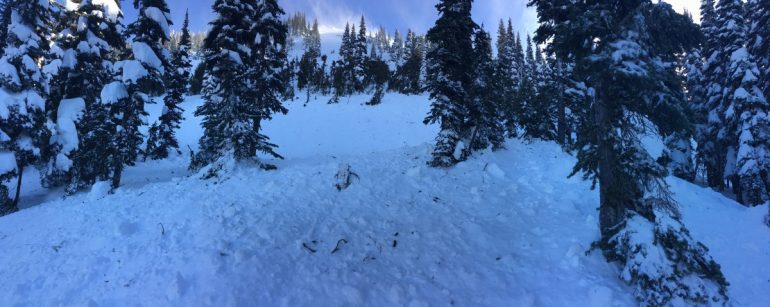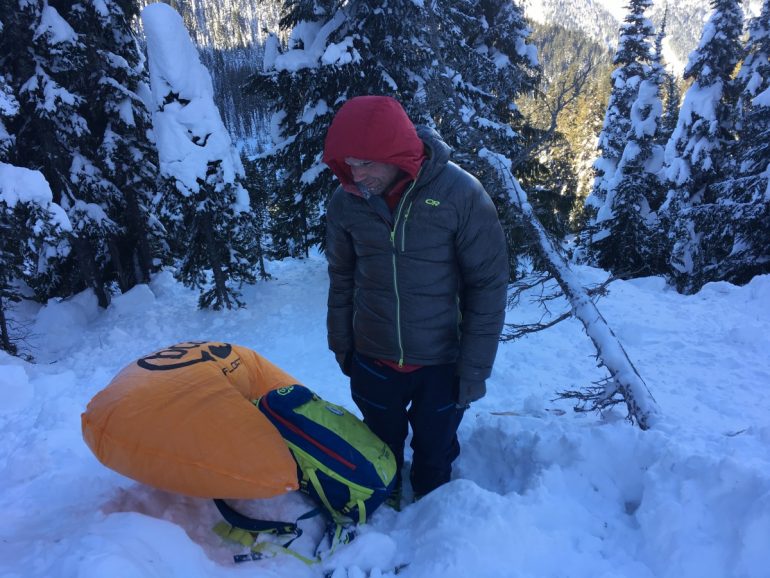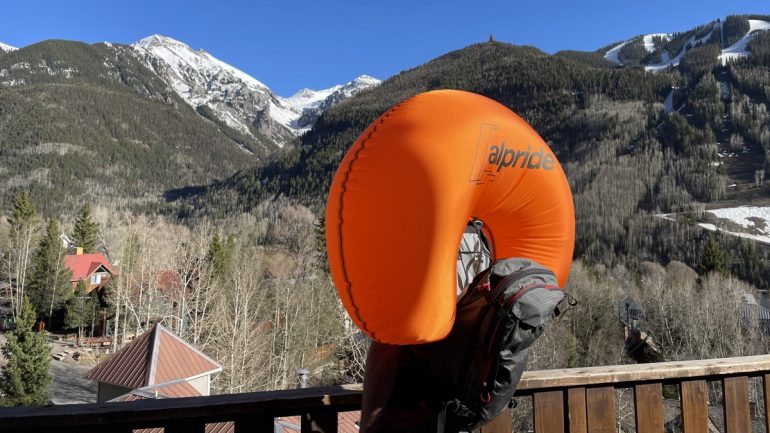Last month, Outside ran a piece advocating for more widespread avalanche airbag use.
Christopher Van Tilburg, a trained physician and respected voice in the wilderness medicine community and the author of that piece, has some important questions – the most critical, about day-to-day airbag use is front and center.
The Outside story piggybacked Van Tilburg’s December 2021 article in Wilderness and Environmental Medicine titled “Should Avalanche Airbags Be Standard Avalanche Safety Equipment?” Although Van Tilburg asks this question, he comes down firmly on the side of airbags as effective at saving lives when answering it.
In conversation, Van Tilburg is earnest: he’s not a monotheistic airbag proselytizer, but someone wanting data to dictate best practices. He said during our discussion that his recent work on airbags was “about me just wanting people to be fully educated.”
His journal article cites vital points that have trickled into the well-cited literature when considering the efficacy of airbags. The most visually profound stat involves Meier and Harvey’s study using dummies in avalanche scenarios wearing airbags and no airbags. Here’s how Van Tilburg summarizes the findings:
“Of the 5 dummies without airbags, burial depth was a mean of 43 cm, and only 1 of 5 was visible from the surface. In contrast, of 14 dummies with airbags, burial depth was a mean of 15 cm, with all 14 visible from the surface. This study also found that among the 14 airbag dummies, the head was visible for all but 5 and the airway was less than 10 cm below the surface for all but 2.”
According to the study, airbags might help prevent a fatality by preventing a critical burial (airway obstructed). Or in the event of a critical burial, the victim may not be resting too far under the surface.
The paper also summarizes burial time and companion rescue data while employing a transceiver. Transceivers work. They help locate victims and categorically reduce burial time. Yet, of the three studies cited about transceivers, one found no significant reduction in mortality, whereas the others found a decrease from 68% to 54% and 70% to 55%, respectively.
Van Tilburg acknowledges the transceiver data has limitations. But he pounces on the fact that mortality rate reduction using an airbag or a transceiver is similar.
“However, airbags help prevent burial, whereas transceivers are employed once a person is caught in an avalanche and buried,” is the exclamation point statement with which van Tilburg begs the question asking why we haven’t as a community adopted airbags more universally.
In Outside, Van Tilburg also explains airbags likely help prevent trauma, while some models that self-deflate after a prescribed amount of time may prevent asphyxia.
But still, airbags are not defacto gear for many backcountry users. The common barriers to airbag use Van Tilburg, and others mention, but are not limited to, are cost, the notion that people are less risk-averse when wearing safety gear, the cumbersome technology, and the weight of airbag packs.

Looking uphill at the slide that took out Ian Nicholson in the Washington backcountry. Photo: Cimarrom Wortham.
Ian’s Slide
I spoke with IFMGA/UIAGM mountain guide Ian Nicholson as he was unceremoniously stuck in traffic due to a closed Snoqualmie Pass. Nicholson began by relaying his own experience in a slide, and his survival, which he attributes, in part, to an airbag. Earlier, I had sent him Van Tilburg’s journal article to discuss.
Working for the Northwest Avalanche Center (NWAC) at the time of his accident, Nicholson was skiing on a day when they miscalculated wind direction and underestimated its force. Nicholson noticed minor signs of wind loading as they were in the trees. At an opening, Nicholson said he stopped in his tracks, sensed the “pencil hard windslab,” and pivoted. He began to collect some data.
“Even though I’m on a big slope, I’m not feeling the size of the slope because I’m two ski lengths from my friends, standing in the woods,” said Nicholson. “It’s a big slope, but I’m just on the very edge of it. And I do all my measuring, how thick it is, all that kind of stuff. And I went to do a small slope test, so I stepped over the skin track and jumped to see if I got a crack above the skin track. Instead of a crack at my skis, it cracks like 50 feet above me. And releases.”
Nicholson said at that moment, he recalled that roughly 20% of avalanche fatalities among those wearing an airbag failed to pull the trigger, waited too long to pull the trigger, or had the trigger packed away.
“I had my trigger out,” he recalled. “I’m like, ‘I’m just going to pull this like, whatevs.’ I didn’t even think of the avalanche. I then get swept off my feet and start flying down the hill. Going faster, faster. Going so fast that I hear the air moving around my ears.”
He whacked a tree, the airbag took much of the force, slid nearly a quarter of a mile, hit more trees, and stopped roughly 400 feet lower. His head was on the surface.

an Nicholson and the deployed airbag he attributes to still being around to enjoy the backcountry. (Photo: Cimarron Wortham)
In our subsequent conversation, after detailing the slide, Nicholson was a matter of fact in his assessment that he wears an airbag pack because he is less likely to be buried. But, like many, Nicholson does not wear an airbag pack all the time.
“I don’t have a set cut off,” he said about his calculus of when or when not to wear an airbag pack. “It has something to do with my level of uncertainty. I do think if there’s any, even modest avalanche danger, I do generally default to wearing an airbag pack. And when the odds of any sizable avalanche are very low, then I do not wear one.” He specified sizable as size two or bigger.
Nicholson also specified certain spring conditions when he’s likely going lighter, sans airbag, and taking advantage of more stable conditions. But, mid-winter, when uncertainty rears its head, that more often than not means airbag time.
He cited regions where local forecasters publish four out of seven days a week as a concrete example of when uncertainty might exist.
“So you have a higher level of uncertainty in those areas because those forecasters don’t work seven days a week,” Nicholson said. “You’ve got a lot of uncertainty in your forecast. Anytime you have uncertainty, you should take more measures.”
In other words, shovel, beacon, probe….airbag.
Hurdles
“We hammer the fact that people should wear a transceiver, shovel, and probe; we just pound that into everybody,” said Van Tilburg.
In writing his series of articles, Van Tilburg drills down on the idea that many backcountry users are misinformed. “My question was, are we misleading people thinking that they’re bringing the safest equipment when they may not be, for one,” Van Tilburg said. “And for two, avalanche transceivers do a horrible job at saving lives. They’re just not very effective at saving lives. I think people are misled.”
In the journal article, Van Tilburg concludes, “based on the literature, if one wants to maximize safety in avalanche terrain, one should use an airbag in addition to other standard safety tools. An airbag is an effective tool at reducing mortality and is the only tool that helps prevent burial.”
The three leading North American avalanche advocacy organizations are the Canadian Avalanche Association (CAA), American Institute for Avalanche Research and Education (AIARE), and the American Avalanche Association (A3). Van Tilburg says none have formally committed to recommending airbag use. However, he does note some exceptions where these organizations mention or discuss airbags at further length in their course offerings.
“Change is hard for people. Right?”, said Van Tilburg. “Change is hard for humans, so to change their dogma for people, to change their dogma from transceiver, shovel, probe to a transceiver, shovel, probe, and an airbag is just pure and simple difficult for humans.”
I ended my conversation with Van Tilburg, asking if he saw any valid argument that should prevent a reputable organization from taking a stance, not necessarily against airbags or for them, but remaining indecisive.
“Is there a valid case to be made for the indecision?” I asked.
“Not with the aggressiveness that people promote transceiver, shovel, and probe,” he replied. “If you’re going to promote transceiver, shovel, and probe aggressively, you can’t exclude airbags because the data on airbags is better. It shows that it saves more lives.”
Jason Albert comes to WildSnow from Bend, Oregon. After growing up on the East Coast, he migrated from Montana to Colorado and settled in Oregon. Simple pleasures are quiet and long days touring. His gray hair might stem from his first Grand Traverse in 2000 when rented leather boots and 210cm skis were not the speed weapons he had hoped for. Jason survived the transition from free-heel kool-aid drinker to faster and lighter (think AT), and safer, are better.

